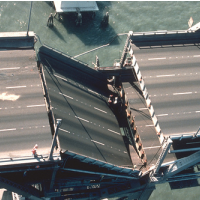One in Eight California Bridges Are Rated “Structurally Deficient”
 San Francisco Bay Bridge after the Loma Prieta earthquake in 1989 (photo: Joe Lewis)
San Francisco Bay Bridge after the Loma Prieta earthquake in 1989 (photo: Joe Lewis)
The downside of California’s early, energetic embrace of bridge and road building this century is that much of its infrastructure is now in need of repair and replacement.
Although the state has pursued regular seismic upgrades, inspired by major earthquakes in 1989 (Loma Prieta) and 1994 (Northridge), a report (pdf) by Transportation for America ranked California 33rd in the nation in 2010 for the overall condition of its bridges.
One in eight bridges in California are rated “structurally deficient,” a fact of growing importance in light of last week’s bridge collapse in Washington state. In 2012, the Federal Highway Administration said 11% of the nation’s bridges, or 67,000, were structurally deficient, and earlier this year, the American Society of Civil Engineers said that Americans make 210 million trips across them.
Most bridges are designed to last 50 years; California’s average bridge is 44.4 years old. More than 8,300 state bridges are at least 50 years old, and by 2030 that number will double without a major effort to replace them.
Much of the state’s bridge work is funded by the federal government. In 2008, the state received $907 million. But the Transportation for America report estimated that each licensed driver in the state would have to pay $323 to pay for all the necessary work identified by the state in 2009.
About half of the state’s 24,542 highway bridges, as of 2010, were owned by the state. Cities, towns and counties owned 11,710 and 545 were owned by federal agencies or another entity, like a private business. Although nine of the Top 10 most heavily travelled bridges are in Los Angeles County, San Francisco County has the highest percentage of problematic structures in the state. Forty of its 116 bridges (34.5%) are structurally deficient. S.F. County is followed by Madera County (32.3% of 229), Yuba County (27.6% of 127), Lake County (21.7% of 120) and Alameda County (21.6% of 601).
The best bridges are in Imperial County (5.8% of 428), San Diego County (5.5% of 1,442), Orange County (4.9% of 1,115), Inyo County (4.5% of 67) and Alpine County (3.1% of 32).
The bridge in Washington state collapsed after the driver of a truck hauling equipment bumped against the steel framework, disturbing a structure whose integrity was not considered enfeebled, but whose older design left it endangered if any part was dislodged. The term for that vulnerability is “fracture critical.”
The Minnesota bridge that collapsed in 2007, killing 13 people, was also a fracture critical bridge.
California has 210 bridges that sport the same “truss” design as the Washington and Minnesota bridges. The California Department of Transportation (Caltrans) quickly inspected 26 state-owned truss bridges and put up some signs warning about truck height limits, according to the San Jose Mercury News.
California reportedly has 1,038 fracture critical bridges and a year ago Caltrans proposed inspecting 48 of them.
–Ken Broder
To Learn More:
Washington State Bridge Collapse Could Echo Far Beyond Interstate (by Kirk Johnson, New York Times)
Washington Bridge Collapse Spotlights California's Aging Bridges (by Pete Carey, Lisa Vorderbrueggen and Steven Harmon, San Jose Mercury News)
Bridge Collapse Shines Light on Aging Infrastructure (by Marisol Bello , USA Today)
2013 Report Card for America’s Infrastructure (American Society of Civil Engineers)
The Fix We’re In For: The State of California’s Bridges (Transportation for America) (pdf)
- Top Stories
- Controversies
- Where is the Money Going?
- California and the Nation
- Appointments and Resignations
- Unusual News
- Latest News
- California Forbids U.S. Immigration Agents from Pretending to be Police
- California Lawmakers Urged to Strip “Self-Dealing” Tax Board of Its Duties
- Big Oil’s Grip on California
- Santa Cruz Police See Homeland Security Betrayal in Use of Gang Roundup as Cover for Immigration Raid
- Oil Companies Face Deadline to Stop Polluting California Groundwater





